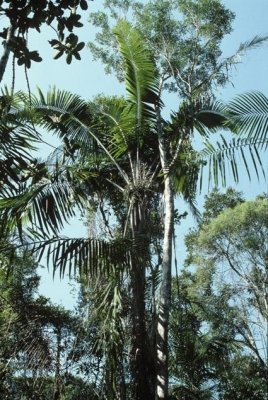Ravenea lakatra
(Jum.) Beentje
Arecaceae
Common Name:

Plant growing in native habitat in Manombo, Madagascar
Photograph by: Henk Beentje
Image credit to Palmweb

Plant growing in native habitat in Manombo, Madagascar
Photograph by: Henk Beentje
Image credit to Palmweb

Stem
Photograph by: Henk Beentje
Image credit to Palmweb

Fruiting plant
Photograph by: Henk Beentje
Image credit to Palmweb


Fibres hung out to dry
Photograph by: John Dransfield
Image credit to Palmweb

Extracted fibres, hung up to dry
Photograph by: John Dransfield
Image credit to Palmweb
General Information
Ravenea lakatra is a single-stemmed, evergreen palm tree growing 15 - 30 metres tall. The unbranched stem can be 30 - 50cm in diameter, it is topped by a crown of 8 - 10 large leaves that can be up to 3.5 metres long[
455- Title
- Flore de Madagascar et des Comores
- Publication
-
- Author
- Humbert H.
- Website
- http://www.biodiversitylibrary.org/
- Publisher
- Museum National D'Histoire Naturelle; Paris
- Year
- 1946 - 1984
- ISBN
-
- Description
- Written in French, an excellent flora of the area though it has not been completed. Available for download from the Internet.
].
The plant is harvested from the wild for local use as a food and source of weaving material.
This species has an extremely wide range but at each of the known sites there are only a few individuals. The population is estimated to number fewer than 30 mature trees and is declining. The main threats to this species are habitat loss through clearance for shifting agriculture and logging and harvesting of the leaves to be used in weaving. Excessive harvesting impacts the reproductive output of the species. The plant is classified as 'Critically Endangered' in the IUCN Red List of Threatened Species(2013)[
338- Title
- IUCN Red List of Threatened Species
- Publication
-
- Author
-
- Website
- http://www.iucnredlist.org/
- Publisher
-
- Year
- 0
- ISBN
-
- Description
- A list of plants under threat and facing possible extinction, usually with brief details of the threats and information on habitat.
].
Known Hazards
None known
Botanical References
455- Title
- Flore de Madagascar et des Comores
- Publication
-
- Author
- Humbert H.
- Website
- http://www.biodiversitylibrary.org/
- Publisher
- Museum National D'Histoire Naturelle; Paris
- Year
- 1946 - 1984
- ISBN
-
- Description
- Written in French, an excellent flora of the area though it has not been completed. Available for download from the Internet.
Range
Africa - eastern Madagascar.
Habitat
Moist lowland forest on slight mid slopes or ridge crests; at elevations from 50 - 1,200 metres[
338- Title
- IUCN Red List of Threatened Species
- Publication
-
- Author
-
- Website
- http://www.iucnredlist.org/
- Publisher
-
- Year
- 0
- ISBN
-
- Description
- A list of plants under threat and facing possible extinction, usually with brief details of the threats and information on habitat.
].
Properties
| Conservation Status | Critically Endangered |
| Edibility Rating |      |
| Other Uses Rating |      |
| Habit | Evergreen Tree |
| Height | 22.00 m |
| Self-fertile | No |
| Cultivation Status | Wild |
Cultivation Details
The leaves of this species are exploited by local people for weaving hats and individual palms may be pruned into juvenility by constant harvest of the emerging leaves[
338- Title
- IUCN Red List of Threatened Species
- Publication
-
- Author
-
- Website
- http://www.iucnredlist.org/
- Publisher
-
- Year
- 0
- ISBN
-
- Description
- A list of plants under threat and facing possible extinction, usually with brief details of the threats and information on habitat.
].
A dioecious species, both male and female forms need to be grown if fruit and seed are required[
455- Title
- Flore de Madagascar et des Comores
- Publication
-
- Author
- Humbert H.
- Website
- http://www.biodiversitylibrary.org/
- Publisher
- Museum National D'Histoire Naturelle; Paris
- Year
- 1946 - 1984
- ISBN
-
- Description
- Written in French, an excellent flora of the area though it has not been completed. Available for download from the Internet.
].
Edible Uses
The palm heart is eaten[
]. The apical bud, often known as a 'palm heart', is eaten as a vegetable[
]. Eating this bud leads to the death of the tree because it is unable to make side shoots[
K- Title
- Plants for a Future
- Author
- Ken Fern
- Description
- Notes from observations, tasting etc at Plants For A Future and on field trips.
].
Medicinal
None known
Other Uses
The leaves are used for weaving hats[
338- Title
- IUCN Red List of Threatened Species
- Publication
-
- Author
-
- Website
- http://www.iucnredlist.org/
- Publisher
-
- Year
- 0
- ISBN
-
- Description
- A list of plants under threat and facing possible extinction, usually with brief details of the threats and information on habitat.
].
Propagation
Seed -
If you have any useful information about this plant, please leave a comment. Comments have to be approved before they are shown here.







 Useful Tropical Plants Database 2014 by
Ken Fern,
web interface by
Ajna Fern
with help from
Richard Morris.
Useful Tropical Plants Database 2014 by
Ken Fern,
web interface by
Ajna Fern
with help from
Richard Morris.